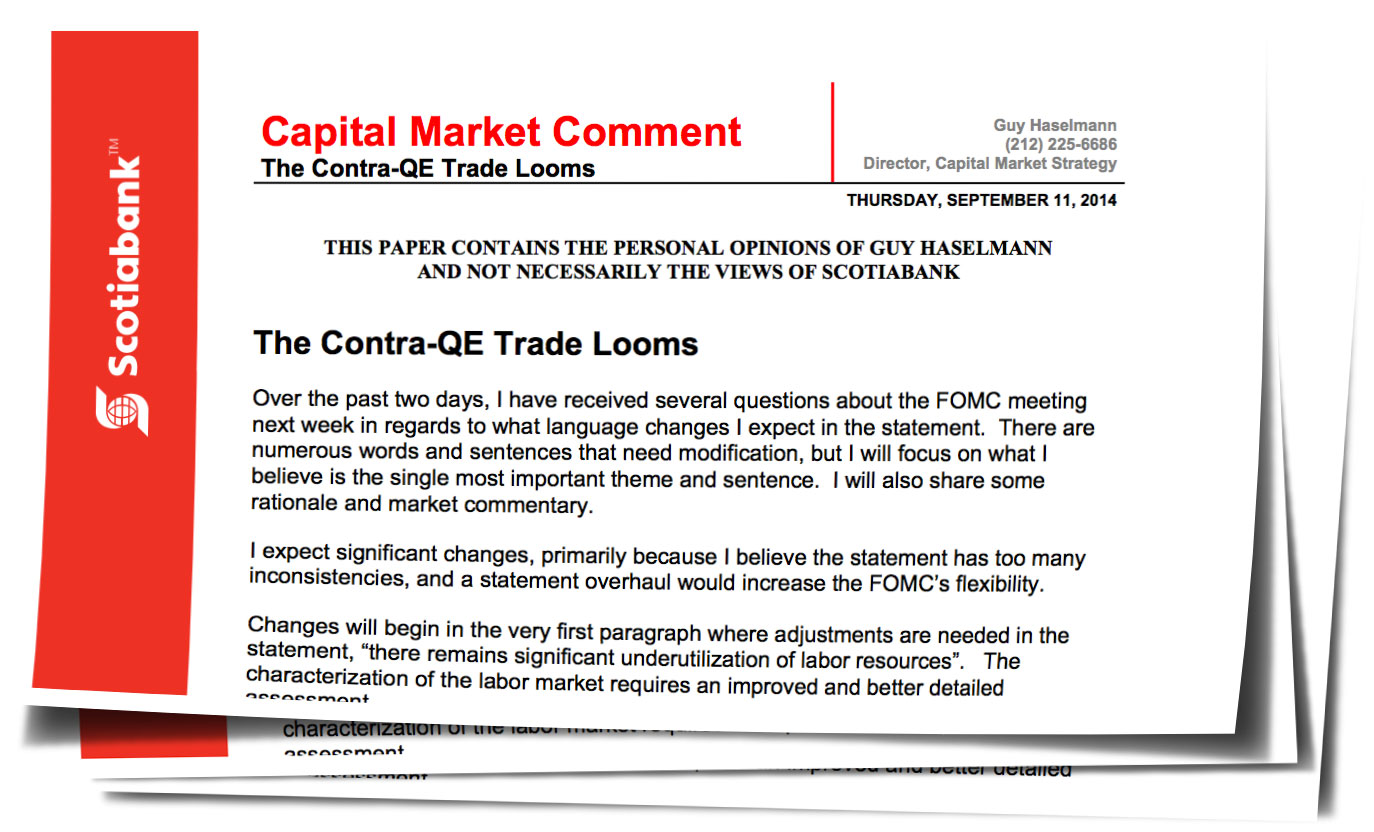THIS PAPER CONTAINS THE PERSONAL OPINIONS OF GUY HASELMANN
AND NOT NECESSARILY THE VIEWS OF SCOTIABANK
The Contra-QE Trade Looms
by Guy Haselmann, Director, Capital Markets Strategy, Scotiabank GBM
Over the past two days, I have received several questions about the FOMC meeting next week in regards to what language changes I expect in the statement. There are numerous words and sentences that need modification, but I will focus on what I believe is the single most important theme and sentence. I will also share some rationale and market commentary.
I expect significant changes, primarily because I believe the statement has too many inconsistencies, and a statement overhaul would increase the FOMC’s flexibility. Changes will begin in the very first paragraph where adjustments are needed in the statement, “there remains significant underutilization of labor resources”. The characterization of the labor market requires an improved and better detailed assessment.
Most importantly, I expect the statement to move away from the calendar guidance that is imposed by the words, “appropriate to maintain the current target range for the federal funds rate for a considerable time after the asset purchase program ends”.
The phrase “considerable time” is restrictive, because it is a quasi-promise that markets interpret as a period of at least six months. If the words are not removed entirely, then a qualifying contingency is likely to be added. The FOMC wants to increase its flexibility and can do so best by eliminating these words and moving to a ‘state-contingent’ position.
Cleveland Fed President Mester, a voter in 2014, said last week, “Rather than think of calendar time, it’s better thinking of economic conditions”. In other words, the FOMC will try to tie any future action to the state of the economy and the progress it makes toward moving closer toward its dual mandates.
On this front, the Fed may already have been too slow in shifting the path to ‘normalization’. It seems obvious to me that inflation has been stable and that labor markets have moved substantially toward ‘close to normal’ levels; yet, monetary policy has remained colossally far from normal. Mester also said last week, “We’ve moved closer to the Fed’s goals, as that happens the Fed is going to have to be normalizing its policy”. Other FOMC members have made similar statements.
After years of “pedal to the metal” accommodation encouraging aggressive risk- seeking behavior, the FOMC (justifiably) has great concern about how even a subtle shift in guidance may roil financial markets. This is a dilemma of its own making.
The only thing the Fed can do to diminish market fallout is to make changes subtlely, gradually, and with tempering contingencies. In the past, I labelled such actions Fed’s Great Aunt Addy Policy (in honor of my Aunt Addy who drove simultaneously with one foot on the accelerator and one on the brake).
The Fed will not be able to avoid agitating markets. I have argued for a long time that the longer the Fed continues its accommodative policies - policies that push markets into the “right tail” - the greater and deeper the fallout will be into the “left-tail” of the distribution curve. (The only way this would not occur would be if the longer-run economic fundamentals justified valuations – which they do not.)
This is a core reason why Fed policy itself has become a source of financial instability. Removing the words “considerable period” is really the removal of a powerful Fed ‘promise’. Risk assets can now have greater downside as the “Fed put” or downside protection is moving farther ‘out-of-the-money’.
It was inevitable that this day would eventually arrive. The FOMC has likely been more worried about it behind closed doors, than in public. Publically, Yellen and others have countered any allegations of having created market bubbles with comments about “monitoring the situation” and using “macro-prudential policy”. These will prove to be baseless words once markets begin to recalibrate ‘normalization’ away from 6 years of extreme accommodation.
Removing the Fed’s ‘promise’ and moving toward normalization should provide the initial warning of the market’s reaction function to this subtle policy shift. The magnitude of the reaction is likely to surprise the Fed. However, similar to past cycles of boom and bust, it is improbable that the Fed will take any responsibility should the fallout get excessive or problematic.
Timing remains tricky as it is possible that the grand finale waits for the first hike in rates to fully react. On the other hand, markets typically try to price in the Fed’s final destination as quickly as possible, unlike the Fed who cares more about the path.
Roiled Markets / Contra-QE Trades
The best trades will be the opposite of the ones that worked under QE.
This means risk-off: Rising USD; short credit, HY, IG and SPX (etc), Long Treasuries vs. European bonds. Also Treasury curve flatteners (but too much negative carry to hold, so look for opportunities to buy 30 year Treasury bonds outright).















